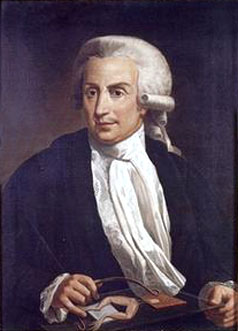| Luigi Galvani  Born: 9-Sep-1737 Born: 9-Sep-1737
Birthplace: Bologna, Italy
Died: 4-Dec-1798
Location of death: Bologna, Italy
Cause of death: unspecified
Remains: Buried, Corpus Domini, Bologna, Italy
Gender: Male
Religion: Roman Catholic
Race or Ethnicity: White
Sexual orientation: Straight
Occupation: Doctor Nationality: Italy
Executive summary: Explored bioelectrical phenomena Italian physiologist, after whom galvanism received its name, born at Bologna on the 9th of September 1737. It was his wish in early life to enter the church, but by his parents he was educated for a medical career. At the University of Bologna, in which city he practiced, he was in 1762 appointed public lecturer in anatomy, and soon gained repute as a skilled though not eloquent teacher, and, chiefly from his researches on the organs of hearing and genito-urinary tract of birds, as a comparative anatomist.
His celebrated theory of animal electricity he enunciated in a treatise, "De viribus electricitatis in motu musculari commentarius", published in the 7th volume of the memoirs of the Institute of Sciences at Bologna in 1791, and separately at Modena in the following year, and elsewhere subsequently.
The statement has frequently been repeated that, in 1786, Galvani had noticed that the leg of a skinned frog, on being accidentally touched by a scalpel which had lain near an electrical machine, was thrown into violent convulsions; and that it was thus that his attention was first directed to the relations Of animal functions to electricity. From documents in the possession of the Institute of Bologna, however, it appears that twenty years previous to the publication of his Commentary Galvani was already engaged in investigations as to the action of electricity upon the muscles of frogs.
The observation that the suspension of certain of these animals on an iron railing by copper hooks caused twitching in the muscles of their legs led him to the invention of his metallic arc, the first experiment with which is described in the third part of the Commentary, with the date September 20, 1786. The arc he constructed of two different metals, which, placed in contact the one with a frog's nerve and the other with a muscle, caused contraction of the latter. In Galvani's view the motions of the muscle were the result of the union, by means of the metallic arc, of its exterior or negative electrical charge with positive electricity which proceeded along the nerve from its inner substance. Alessandro Volta, on the other hand, attributed them solely to the effect of electricity having its source in the junction of the two dissimilar metals of the arc, and regarded the nerve and muscle simply as conductors.
On Galvani's refusal, from religious scruples, to take the oath of allegiance to the Cisalpine republic in 1797, he was removed from his professorship. Deprived thus of the means of livelihood, he retired to the house of his brother Giacomo, where he soon fell into a feverish decline. The republican government, in consideration of his great scientific fame, eventually, but too late, determined to reinstate him in his chair, and he died at Bologna on the 4th of December 1798. Wife: Lucia (dau. Professor Galeazzi, m. 1762, d. 30-Jun-1790)
University: University of Bologna (1759)
Professor: Lecturer of Anatomy, University of Bologna (1762-97)
Eponyms galvanize
Author of books:
De Viribus Electricitatis in Motu Musculari Commentarius (1791, essay)
Dell'Uso e dell'Attivitą dell'Arco Conduttore nella Contrazione dei Muscoli (1794)
Do you know something we don't?
Submit a correction or make a comment about this profile
Copyright ©2019 Soylent Communications
|